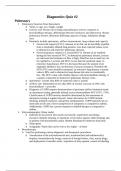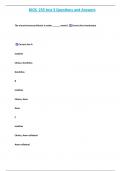Diagnostics Quiz #2
Pulmonary
Pulmonary Function Tests/Spirometry
oVaries w/ age, sex, height, weight
oUsed to eval: Preop eval of lungs and pulmonary reserve, response to bronchodilator therapy, differentiate between restrictive and obstructive chronic
pulmonary disease, determine diffusing capacity of lungs, inhalation allergy tests
oRoutinely include spirometry, airflow measurement, lung volume and capacity Forced vital capacity (FVC): Amount of air that can be forcefully expelled
from a maximally inflated lung position. Less than expected values occur in obstructive and restrictive pulmonary diseases. Forced expiratory volume in 1 second (FEV1): V olume of air expelled during the first second of FVC. In obstructive pulmonary disease, airways are narrowed and resistance to flow is high. Therefore not so much air can be expelled in 1 second, and FEV1 is less than the predicted value. In restrictive lung disease, FEV1 is decreased because the amount of air originally inhaled is low, not because of airway resistance. Therefore the FEV1/FVC ratio should be measured. In restrictive lung disease a normal value is 80%, and in obstructive lung disease this ratio is considerably less. The FEV1 value will reliably improve with bronchodilator therapy if a spastic component to obstructive pulmonary disease exists. .
oSpirometry: Greater than 80% of expected value is normal
oAirflow rate: Diminished at less than 60% of normal. Increase of 20% with bronchodilator = prescribe
oDiagnosis of COPD requires demonstration of persistent airflow limitation based on spirometry testing, generally defined as post bronchodilator FEV1/FVC <70%.
Classification of COPD severity should be determined by the assessment of spirometry testing at regular intervals. Some risk factors for COPD include smoking, pollution exposure, and genetic predisposition. COPD typically has an onset later in life and a slower progression of symptoms as compared to asthma. Additionally, COPD has a poorer response to inhaled therapy as compared to asthma.
Polysomnography (Sleep study)
oIndicated in any person who snores excessively; experiences narcolepsy, excessive daytime sleeping, or insomnia; or has motor spasms while sleeping; and
in patients with documented cardiac rhythm disturbances limited to sleep time.
oSleep apnea
oActigraphy: Watch that can be worn a few nights – at home
Bronchoscopy
oUsed for performing various diagnostic and therapeutic procedures. oVisualization of the tracheobronchial tree; transbronchial and endobronchial biopsies; bronchoalveolar lavage; removal of foreign bodies, clots, mucus plugs; and deployment of metallic stents. Aspiration of deep sputum, control of bleeding oCommon clinical indications for bronchoscopy include (but are not limited to) hemoptysis, malignancy, interstitial lung disease, pulmonary infections, and pleural effusion.
Pleural Tap (Thoracentesis and pleural fluid analysis)
oPerformed to determine the cause of an unexplained pleural effusion. It is also performed to relieve the intrathoracic pressure that accumulates with a large volume of fluid and inhibits respiration.
oTransudates are most frequently caused by congestive heart failure, cirrhosis, nephrotic syndrome, and hypoproteinemia. Clear/serous, protein < 3
oExudates are most often found in inflammatory, infectious, or neoplastic conditions.
Cloudy/turbid, + WBC, protein > 3, Low glucose, pleural fluid/serum LCH > 0.6, oCXR is obtained before thoracentesis to ensure that the pleural fluid is mobile and
accessible to a needle placed within the pleural space.
Diagnosis of Influenza oRNA/DNA-PCR – Very specific. Part of respiratory virus panel
oAntibody - Front-line testing, non-specific
Pulmonary Embolus Diagnosis and Management
oAcquired Risk Factors
oChest pain, SOB, feelings of doom, pleurodynia (pain w/ deep inhale), Tachycardia, hypoxemia, S4 gallop
oIncreased D-Dimer, decreased fibrinogen, V/P mismatch, low PO2 and high /low PCO2, reduce diffusion capacity, Enlarged PA on CXR, increase alveolar
dead space, R ventricular dysfunction, S1Q3T3 on ECG, Pulm artery emboli on CT
Ventilation/Perfusion Scan oNuclear medicine
oOften used to detect PE – Will show mismatch in V/P
CT Scan
oDiagnosing and evaluating pathologic conditions such as tumors, nodules, hematomas, parenchymal coin lesions, cysts, abscesses, pleural effusion, and enlarged lymph nodes affecting the lungs and mediastinum. Tumors and cysts of the pleura and fractures of the ribs can also be seen. When an intravenous (IV) contrast material is given, vascular structures can be identified and a diagnosis of





